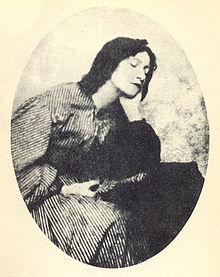Elizabeth Siddal
| Elizabeth Siddal | |
|---|---|

Elizabeth Siddal, circa 1860
|
|
| Born |
25 July 1829 London, England |
| Died | 11 February 1862 (aged 32) London, England |
| Occupation | artist, artist's model |
| Spouse(s) | Dante Gabriel Rossetti |
| Parent(s) | Charles Crooke Siddall and Elizabeth Eleanor Siddall (née Evans) |
Elizabeth Eleanor Siddal (25 July 1829 – 11 February 1862) was an English artists' model, poet and artist. She was painted and drawn extensively by artists of the Pre-Raphaelite Brotherhood, including Walter Deverell, William Holman Hunt, John Everett Millais (including his notable 1852 painting Ophelia) and her husband, Dante Gabriel Rossetti. She featured prominently in Rossetti's early paintings of women.
Named Elizabeth Eleanor Siddall, after her mother, 'Lizzie' Siddall was born on 25 July 1829, at the family’s home at 7 Charles Street, Hatton Garden. Her parents were Charles Crooke Siddall, who claimed his family descended from nobility, and Eleanor Evans, from a family of English and Welsh descent. At the time of her birth, her father had a cutlery-making business but around 1831, her family moved to the borough of Southwark, in south London, a less salubrious area than Hatton Garden. In Southwark the rest of Lizzie Siddall's siblings were born: Lydia, to whom she was particularly close, Mary, Clara, James and Henry. Although there is no record of Lizzie Siddall having attended school, she could read and write, presumably having been taught by her parents. She developed a love of poetry at a young age, after discovering a poem by Tennyson on a scrap of newspaper that had been used to wrap a pat of butter; the discovery was an inspiration to start writing her own poems.
The spelling 'Siddall' was changed to Siddal when Dante Gabriel Rossetti dropped the second 'l'. She was first noticed by Walter Deverell in 1849, while she was working as a milliner in Cranbourne Alley, London. Whether Siddal had any artistic aspirations is unknown, though she loved poetry. She was employed as a model by Deverell and through him was introduced to the Pre-Raphaelites. William Michael Rossetti, her brother-in-law, described her as "a most beautiful creature with an air between dignity and sweetness with something that exceeded modest self-respect and partook of disdainful reserve; tall, finely-formed with a lofty neck and regular yet somewhat uncommon features, greenish-blue unsparkling eyes, large perfect eyelids, brilliant complexion and a lavish heavy wealth of coppery golden hair."
...
Wikipedia
